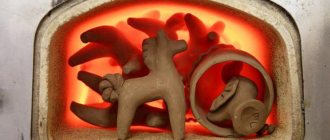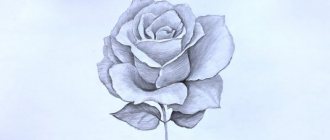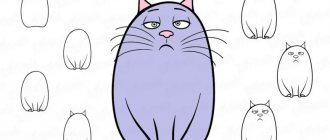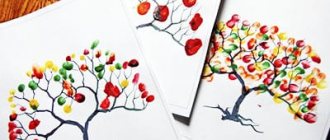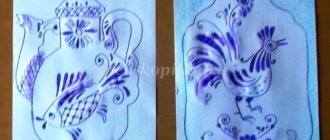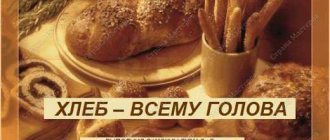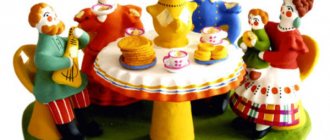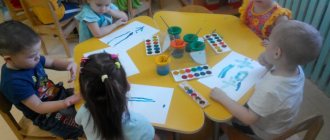Simple coloring pages of Dymkovo patterns for young children
Dymkovo toys (drawing templates, in particular) should be chosen based on the age of the child who will work with them.
Children's development will benefit from painting large components of a drawing, using the most saturated colors.
Among the most popular options for such pictures:
| Drawing for coloring | |
| Horse. The task for the child will be to color the horse in the way he thinks will be as beautiful as possible. Typically, children are asked to use red, white, orange and yellow pencils. This set of colors, as a rule, is sufficient not only for their individual use, but also for creating new shades. In this version of the coloring book, the child, if desired, can complete the animal’s face, or can simply add brightness to the picture, without adding patterns to it. | |
| Matryoshka. Coloring this picture of a matryoshka doll is best combined with telling your child the history of the origins of the original Russian toy. It will also be interesting for the child to learn the principle of playing with such a wooden doll. Pencils of red, black, white and yellow are usually used to add color to this sketch. | |
| Lady. The process of coloring the lady will also be a fun activity for kids. Despite the apparent simplicity of the design, giving it color requires thinking through the shades used in the work. To complicate the task, the child can be given the goal of coloring the outline of a woman so that the items of her clothing match each other and do not merge. For this purpose, it is recommended to invite him to choose a shade to work with from an unlimited number of pencils. Experience shows that children most often choose red, yellow, green, blue, black and white. |
Materials
If we want to make a Dymkovo hinny, for example, its creation involves several stages: modeling, drying, firing, whitewashing, painting. They sculpt the toy in parts. They take oily, washed clay, diluted with sand, and roll it into balls. Then the balls are flattened to form flat cakes, and the body of the toy is made from them. And smaller parts are attached to the body.
Then the toy awaits drying, firing, and whitewashing. And only after the surface has dried, the master begins painting. All the bright patterns decorating the rooster or the lady are simple and unpretentious. This is why preschool children love the painting process. The child likes to make a white figurine bright, to enliven it with paint. But first, the Dymkovo painting patterns presented for children are worked out on paper blanks. Children learn patterns and work with primary colors.
Therefore, the materials for a future toy can be different: clay, acrylic paints, gouache, and paper. Child labor requires the simplest set of materials and tools - thick watercolor paper, gouache, brushes. Older children can work with papier-mâché, that is, paint three-dimensional figures.
Elements and ornaments
The Dymkovo lady, horse, cockerel are a symbol of life itself, the joy of every day. The ornaments depicted on the product are smooth paintings that are combined with geometric patterns. The elements of painting of the Dymkovo toy are directly related to the protective meaning, to the symbolism of Mother Nature.
Various circles - a symbol of the sun, waves - the sky
For example, solar and lunar signs are a symbol of the origin of life, diamonds are associated with fertility, waves are a sign of the sky and celestial moisture. Depicting these signs on a toy means making it not just a nursery rhyme or decoration, but encoding important, sacred information on it.
History and traditions of Dymkovo painting
Dymkovo toy, 19th century.
According to an ancient legend, two squads met near the city late at night. And even though they were allies, in the darkness the warriors could not recognize each other, and a battle took place that claimed many heads. Every spring, the locals held a funeral feast for the victims of the absurd, accidental, and even more tragic battle. History began to be forgotten, but the tradition of organizing a spring meeting remained. And it turned into mass celebrations, a pandemonium festival, at which it was customary to playfully throw painted stucco balls.
Here is such an interesting history of the origin of the direction. It was the demand for balls and whistles that contributed to the development of the direction. This happened in the Dymkovo settlement, the birthplace of an outstanding craft. Over time, masters began to use sculpting and painting techniques: one after another, they carefully passed on their skills to their followers. When the ritual meaning of toys began to be lost, the products themselves began to change - they became more beautiful and artistic. And today, painting of Dymkovo toys has become part of decorative and applied art; ritual significance has receded into the background.
History of the fishery
The Dymkovo toy was “born” in Kirov. Five centuries ago, across the Vyatka River there was a small settlement of Dymkovo, where Tsar Ivan III ordered the resettlement of residents from the northern regions of Russia. Among them were many talented pottery masters, who began active production of toys in the new place. Whole families were involved in the work process: some mined clay and made mixtures from lump chalk; others made toys; still others were burned; the fourth - whitewashed and painted.
The Dymkovo fishery has been developing for four hundred years. During this time, its own themes, images, and characteristic drawings developed. There was no place for inexpressive ornaments or dull shades. The Dymkovo toy is the embodiment of life in the most joyful colors. It is not surprising that by the beginning of the 19th century, whistles from Dymkovo won the love of residents throughout Russia. More than 100 thousand toys were produced per year, which were sold in the capital and Orenburg province. 59 families from Dymkovo worked on their creation. Among the most famous names were the Koshkins and Nikulins.
At the beginning of the 20th century, “dark times” came for the Dymkovo toy. They ceased to enjoy their former popularity, so famous families of pottery artisans began to look for other options for earning money. Exclusive whistles began to be replaced by cheap plaster options. Only one craftswoman, Anna Mezrina, remained faithful to traditional clay making. It is to her that descendants can be grateful for the preservation of the Dymkovo fishery.
(Master E. A. Koshkina and artist A. Denshin)
The artist Alexey Denshin played an equally important role in continuing the traditions of his ancestors. From a young age, he was fascinated by Dymkovo toys, carefully sketching all the known ornaments. Even after the October Revolution, he did not lose hope of attracting attention to folk art: he released handwritten albums and collected collections of toys. His efforts were crowned with success: in the 30s of the 20th century, the Dymkovo fishery began to revive in Kirov.
How to make it?
First, red clay is taken, mixed with brown river sand. This type of clay exists precisely near Vyatka. A figurine is sculpted from it, for example, a rooster, turkey or horse. You have to sculpt the figures in parts. Then they are glued together using liquid clay, and the figure is adjusted by the master. The toy is then dried and fired in a kiln at high temperature. Then they begin to paint it. The patterns are painted with white paint. Previously, paint was made from chalk mixed with milk. Today there are special paints. In addition to white, toys abound in blue, green, and yellow colors, which give them a special cheerfulness. The top of the toys was covered with whipped egg white, which gave them a bright shine and elegance. Each toy is unique because it is made by hand. Among the many figurines collected in museums, you will not find two identical ones. The largest toy museum is located in Kirov.
Master class on painting the Dymkovo lady
Let's look at the painting of the colorful Dymkovo lady using children's works as an example. In this case, you can take not clay, but plasticine, which is more accessible and comfortable for the child. To work you will need plasticine, a modeling board, stacks, a plastic bottle, gouache, squirrel brushes, a marker and cotton swabs.
Action plan:
- You need to roll out a roller from plasticine of any color. Having retreated a place on top of the head, we press down the plasticine so that we get a neck. The head and body can also be made from two parts.
- If you cut off the top of a small plastic bottle, it will be a good blank for a skirt. The lady's torso (plasticine) needs to be attached on top of the plastic blank.
- We coat the entire structure with plasticine, make hands from two plasticine rollers and sculpt a kokoshnik, do not forget to weave a plasticine braid.
- We cover the finished lady with white gouache, a very dense layer. You need to wait until the figure dries.
- Now begins the most interesting stage - painting. It is assumed that the children have already practiced the basics of Dymkovo painting on paper: elements of painting for children can be studied using special recipes. You can also make a sketch on paper, based on which the child will paint a three-dimensional figure.
- You need to act in stages: it is very convenient to draw dots and circles with cotton swabs, which serve as a kind of stamps. It is convenient to draw eyes and eyebrows with a black marker, and a mouth with a red marker.
- The children are instructed in advance what colors they can use in painting. You can talk about the meanings of colors and the symbolism of elements. This is how the child does not paint an abstract picture, but, like a true master, puts meaning into the work and conveys some kind of message.
You can see an example of painting a Dymkovo lady in the video presented. Odnoklassniki
Dymkovo toys are also called Vyatka or Kirov toys. They have a long history, and appeared more than 400 hundred years ago in the settlement of the same name near the Russian city of Vyatka.
Types of Dymkovo toys
Traditional images of Dymkovo toys are a lady, pets, and a turkey. All of them are made in bright colors, calling to show the joy of life. Collectors value figurines with which they can create certain plot compositions.
The Dymkovo toy, despite its canonicity, is exclusive. The fact is that every craftswoman tries to bring her own signature developments into the product. Therefore, it is impossible to find two absolutely identical toys.
Among the most popular images that are “played out” in the Dymkovo toy are the following:
The turkey is as colorful as a peacock, with a characteristic beard decorated with gold leaf. Sizes can vary: from tiny 5 cm to an impressive 40 cm;
A lady is both a sophisticated city lady and a traditional young lady in a kokoshnik. There may be children around her. Gold leaf also adorns individual details;
Lamb - figurines of this animal can have horns of different sizes. A distinctive feature is their gilding. The lambs can be ordinary or in elegant funny clothes;
A horse is a traditional image of an animal in bright blue or “bull’s-eye” colors.
Male images in Dymkovo toys are most often played out in the form of a rider on a horse, a walking city or village “gentleman”. Figurines of pigs, birds, and bells are popular.
